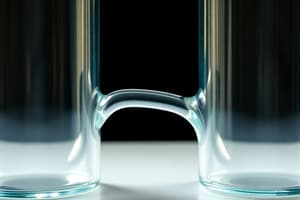Podcast
Questions and Answers
The mean free path is the average distance covered by a molecule between two successive ______.
The mean free path is the average distance covered by a molecule between two successive ______.
True (A)
Diffusion and Brownian motion are examples that provide evidence of molecular ______.
Diffusion and Brownian motion are examples that provide evidence of molecular ______.
False (B)
Avogadro's hypothesis confirms that the number of molecules in gas varies significantly among different gases.
Avogadro's hypothesis confirms that the number of molecules in gas varies significantly among different gases.
False (B)
A real gas behaves like an ideal gas at high pressure and low temperature.
A real gas behaves like an ideal gas at high pressure and low temperature.
Boyle's law states that pressure is directly proportional to volume at constant temperature.
Boyle's law states that pressure is directly proportional to volume at constant temperature.
Charles' law expresses the relationship between volume and temperature of a gas at constant pressure.
Charles' law expresses the relationship between volume and temperature of a gas at constant pressure.
Dalton's law of partial pressures states that the total pressure of a mixture is less than the sum of partial pressures.
Dalton's law of partial pressures states that the total pressure of a mixture is less than the sum of partial pressures.
The universal gas constant R is different for various gases.
The universal gas constant R is different for various gases.
The number of molecules in 22.4 liters of any gas is $6.02 imes 10^{23}$, known as Avogadro number.
The number of molecules in 22.4 liters of any gas is $6.02 imes 10^{23}$, known as Avogadro number.
At low pressure and low temperature, a real gas behaves like an ideal gas.
At low pressure and low temperature, a real gas behaves like an ideal gas.
Flashcards
Mean Free Path
Mean Free Path
The average distance a molecule travels between collisions.
Brownian Motion
Brownian Motion
The random motion of particles suspended in a fluid, caused by collisions with the fluid molecules.
Diffusion
Diffusion
The spreading of one substance into another, driven by the random motion of molecules.
Kinetic Theory of Gases
Kinetic Theory of Gases
Signup and view all the flashcards
Avogadro's Hypothesis
Avogadro's Hypothesis
Signup and view all the flashcards
Ideal Gas
Ideal Gas
Signup and view all the flashcards
Real Gas
Real Gas
Signup and view all the flashcards
Boyle's Law
Boyle's Law
Signup and view all the flashcards
Charles' Law
Charles' Law
Signup and view all the flashcards
Dalton's Law of Partial Pressures
Dalton's Law of Partial Pressures
Signup and view all the flashcards
Study Notes
Mean Free Path
- The mean free path is the average distance a molecule travels between collisions.
- Formula: τ = 1 / √(2πnd2)
- Where n is the number density and d is the molecular diameter.
Molecular Motion Evidence
- Two phenomena demonstrating molecular motion are diffusion and Brownian motion.
Avogadro's Hypothesis
- Kinetic theory supports Avogadro's hypothesis by showing that the number of molecules in a given volume of different gases is the same at the same pressure and temperature.
- R (universal gas constant) is the same for all gases
- This is evidenced from the ideal gas equation (PV/RT = n)
Ideal Gas Behaviour
- Real gases behave like ideal gases at low pressures and high temperatures.
Boyle's Law
- Boyle's law states that at constant temperature, the pressure of a fixed mass of gas is inversely proportional to its volume.
- Formula: P ∝ 1/V (or) PV = constant
Charles's Law
- Charles's Law states that at constant pressure, the volume of a fixed mass of gas is directly proportional to its absolute temperature (measured in Kelvin).
- Formula: V ∝ T (or) V/T = constant
Dalton's Law of Partial Pressures
- Dalton's law states that the total pressure exerted by a mixture of ideal gases is equal to the sum of the partial pressures of the individual gases.
- Formula: P = P1 + P2 + P3 + ... (where P1, P2, P3, etc. are the partial pressures).
Studying That Suits You
Use AI to generate personalized quizzes and flashcards to suit your learning preferences.




